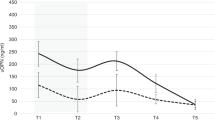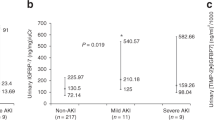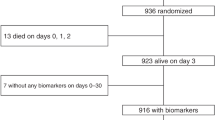Abstract
Objective:
The aim of work was to establish the normal levels of serum and urinary kidney injury molecule-1 (sKIM-1 and uKIM-1) in healthy full-term newborns.
Study Design:
The study included 88 healthy full-term neonates from normal, uncomplicated pregnancies. The serum and urinary concentrations of KIM-1 in the material obtained in the first or second day of life were determined with a commercially available enzyme-linked immunosorbent assay kits. In addition, uKIM-1 was normalized for urinary creatinine concentration.
Results:
Male and female newborns, as well as children in whom the samples were obtained in the first or second day of life, did not differ significantly in terms of their sKIM-1 and uKIM-1 levels. Gestational age correlated inversely with sKIM-1 and positively with uKIM-1, but not with uKIM-1/cr. No correlation was found with birth weight and gender.
Conclusion:
This is the first report of sKIM-1 and uKIM-1 levels in healthy full-term newborns during the first postnatal days. The data from healthy newborns may serve as the reference values for future studies in the youngest children.
This is a preview of subscription content, access via your institution
Access options
Subscribe to this journal
Receive 12 print issues and online access
$259.00 per year
only $21.58 per issue
Buy this article
- Purchase on Springer Link
- Instant access to full article PDF
Prices may be subject to local taxes which are calculated during checkout

Similar content being viewed by others
References
Arant BS Jr . Postnatal development of renal function during the first year of life. Pediatr Nephrol 1987; 1: 308–313.
Mussap M, Noto A, Fanos V, Van Den Anker JN . Emerging biomarkers and metabolomics for assessing toxic nephropathy and acute kidney injury (AKI) in neonatology. Biomed Res Int 2014; 2014: 602526.
Sarafidis K, Tsepkentzi E, Agakidou E, Diamanti E, Taparkou A, Soubasi V et al. Serum and urine acute kidney injury biomarkers in asphyxiated neonates. Pediatr Nephrol 2012; 27: 1575–1582.
Ichimura T, Bonventre JV, Bailly V, Wei H, Hession CA, Cate RL et al. Kidney injury molecule-1 (KIM-1), a putative epithelial cell adhesion molecule containing a novel immunoglobulin domain, is up-regulated in renal cells after injury. J Biol Chem 1998; 273: 4135–4142.
Vaidya VS, Ramirez V, Ichimura T, Bobadilla NA, Bonventre JV . Urinary kidney injury molecule-1: a sensitive quantitative biomarker for early detection of kidney tubular injury. Am J Physiol Renal Physiol 2006; 290: F517–F529.
Chaturvedi S, Farmer T, Kapke GF . Assay validation for KIM-1: human urinary renal dysfunction biomarker. Int J Biol Sci 2009; 5: 128–134.
Bonventre JV . Kidney injury molecule-1 (KIM-1): a urinary biomarker and much more. Nephrol Dial Transplant 2009; 24: 3265–3268.
Han WK, Waikar SS, Johnson A, Betensky RA, Dent CL, Devarajan P et al. Urinary biomarkers in the early diagnosis of acute kidney injury. Kidney Int 2008; 73: 863–869.
Krawczeski CD, Goldstein SL, Woo JG, Wang Y, Piyaphanee N, Ma Q et al. Temporal relationship and predictive value of urinary acute kidney injury biomarkers after pediatric cardiopulmonary bypass. J Am Coll Cardiol 2011; 58: 2301–2309.
van Timmeren MM, Vaidya VS, van Ree RM, Oterdoom LH, de Vries AP, Gans RO et al. High urinary excretion of kidney injury molecule-1 is an independent predictor of graft loss in renal transplant recipients. Transplantation 2007; 84: 1625–1630.
McWilliam SJ, Antoine DJ, Sabbisetti V, Turner MA, Farragher T, Bonventre JV et al. Mechanism-based urinary biomarkers to identify the potential for aminoglycoside-induced nephrotoxicity in premature neonates: a proof-of-concept study. PLoS One 2012; 7: e43809.
Askenazi DJ, Koralkar R, Hundley HE, Montesanti A, Parwar P, Sonjara S et al. Urine biomarkers predict acute kidney injury in newborns. J Pediatr 2012; 161: 270–275.
Genc G, Ozkaya O, Avci B, Aygun C, Kucukoduk S . Kidney injury molecule-1 as a promising biomarker for acute kidney injury in premature babies. Am J Perinatol 2013; 30: 245–252.
Wasilewska A, Taranta-Janusz K, Debek W, Zoch-Zwierz W, Kuroczycka-Saniutycz E . KIM-1 and NGAL: new markers of obstructive nephropathy. Pediatr Nephrol 2011; 26: 579–586.
Han WK, Bailly V, Abichandani R, Thadhani R, Bonventre JV . Kidney Injury Molecule-1 (KIM-1): a novel biomarker for human renal proximal tubule injury. Kidney Int 2002; 62: 237–244.
Kim SS, Song SH, Kim IJ, Yang JY, Lee JG, Kwak IS et al. Clinical implication of urinary tubular markers in the early stage of nephropathy with type 2 diabetic patients. Diabetes Res Clin Pract 2012; 97: 251–257.
Xie Y, Xue W, Shao X, Che X, Xu W, Ni Z et al. Analysis of a urinary biomarker panel for obstructive nephropathy and clinical outcomes. PLoS One 2014; 9: e112865.
Barr DB, Wilder LC, Caudill SP, Gonzalez AJ, Needham LL, Pirkle JL . Urinary creatinine concentrations in the U.S. population: implications for urinary biologic monitoring measurements. Environ Health Perspect 2005; 113: 192–200.
Antoine DJ, Sabbisetti VS, Francis B, Jorgensen AL, Craig DG, Simpson KJ et al. Circulating Kidney Injury Molecule 1 Predicts Prognosis and Poor Outcome in Patients With Acetaminophen-Induced Liver Injury. Hepatology 2015; 62: 591–599.
Sabbisetti VS, Waikar SS, Antoine DJ, Smiles A, Wang C, Ravisankar A et al. Blood kidney injury molecule-1 is a biomarker of acute and chronic kidney injury and predicts progression to ESRD in type I diabetes. J Am Soc Nephrol 2014; 25: 2177–2186.
Guignard JP, Drukker A . Why do newborn infants have a high plasma creatinine? Pediatrics 1999; 103: e49.
Bennett MR, Nehus E, Haffner C, Ma Q, Devarajan P . Pediatric reference ranges for acute kidney injury biomarkers. Pediatr Nephrol 2015; 30: 677–685.
Zwiers AJ, de Wildt SN, de Rijke YB, Willemsen SP, Abdullahi NS, Tibboel D et al. Reference intervals for renal injury biomarkers neutrophil gelatinase-associated lipocalin and kidney injury molecule-1 in young infants. Clin Chem Lab Med 2015; 53: 1279–1289.
Pennemans V, Rigo JM, Faes C, Reynders C, Penders J, Swennen Q . Establishment of reference values for novel urinary biomarkers for renal damage in the healthy population: are age and gender an issue? Clin Chem Lab Med 2013; 51: 1795–1802.
Askenazi DJ, Koralkar R, Levitan EB, Goldstein SL, Devarajan P, Khandrika S et al. Baseline values of candidate urine acute kidney injury biomarkers vary by gestational age in premature infants. Pediatr Res 2011; 70: 302–306.
Acknowledgements
This study was funded by the grant of Medical University of Białystok.
Author information
Authors and Affiliations
Corresponding author
Ethics declarations
Competing interests
The authors declare no conflict of interest.
Rights and permissions
About this article
Cite this article
Kamianowska, M., Szczepański, M., Kulikowska, E. et al. Do serum and urinary concentrations of kidney injury molecule-1 in healthy newborns depend on birth weight, gestational age or gender?. J Perinatol 37, 73–76 (2017). https://doi.org/10.1038/jp.2016.169
Received:
Revised:
Accepted:
Published:
Issue Date:
DOI: https://doi.org/10.1038/jp.2016.169
This article is cited by
-
Urinary biomarkers indicate pediatric renal injury among rural farming communities in Sri Lanka
Scientific Reports (2022)



